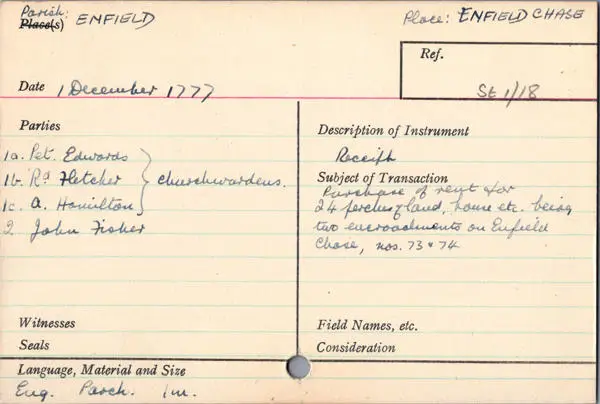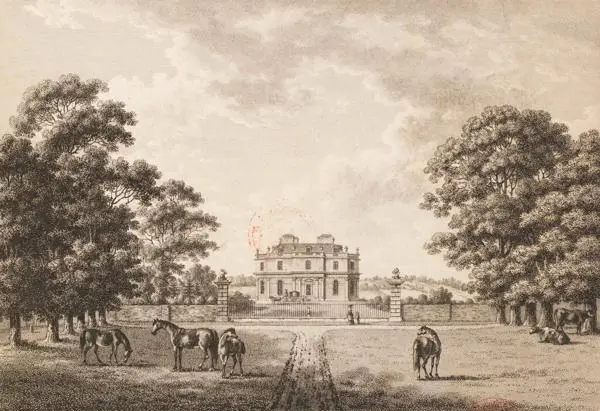The Stowe Collection: a catalogue 75 years in the making
There have not been many silver linings to the COVID-19 pandemic, but over the last two years LMA has taken advantage of the various lockdowns to work towards making some archive collections available that otherwise would have remained difficult to access. One example of this is the ‘Stowe’ archive of the Nugent Chandos Temple Grenville family, Dukes of Buckingham and Chandos, so-called because the main seat of the Duchy was at Stowe Hall in Buckinghamshire.
The archives of the Middlesex and London estates belonging to the family were purchased by the Middlesex Record Office from a bookseller in late 1947; in 1948 this section of the archive was split yet again when the Middlesex Record Office transferred items relating to the inner London area to the County of London Record Office. The merger of these two archive repositories in 1965 formed the Greater London Record Office (now London Metropolitan Archives), and while the two halves of the Stowe archive were physically reunited as a result, both parts of the collection remained uncatalogued and unavailable to the public. One reason for this was the existence of typed and handwritten index cards and lists for the bulk of the collection, meaning that there was already a way in to finding individual items within the collection, for anyone who knew the archive existed and knew exactly what they wanted to see. For everyone else, this collection has been inaccessible for 75 years. The only exceptions to this are the series of records relating to the Wood Family of Littleton, which were catalogued as series ACC/0262/034, 035 and 043.
When looking in March 2020 for projects which could be undertaken by LMA staff at home, in preparation for the first covid lockdown, the index cards and lists for the Stowe collection came to light once more and the possibility of making this rich and varied archive available to the public after all these years was an irresistible prospect.

Using traditional cataloguing methods the 5,600 individual items in this archive would have taken a minimum of nine months to complete for an archivist working full time. The existence of the typed and handwritten lists and index cards for this collection allowed us to think more creatively about how we could make it available to a wider audience in a shorter time-frame. We made use of the ‘More Product Less Process (MPLP)’ ideology, advocated by Mark A. Greene and Dennis Meissner in an article in the periodical ‘The American Archivist’ in 2005. The authors argue that traditional methods of processing archival collections are too slow and result in the proliferation of cataloguing backlogs, preventing researchers from gaining access to the vast wealth of archival material cared for by archive repositories and libraries. They suggested a simpler approach, which involves doing ‘just enough’ to make items accessible to the public.
Taking this as our inspiration, we pulled together and scanned the index cards and other lists for the Stowe archive. Four members of LMA staff spent some of their time at home during lockdown typing all the information from the cards and lists into MS Excel spreadsheets. We left the papers in the order originally decided by the creators of the cards and lists, and retained the original numbers assigned to each item. We were lucky that the majority of the items already had those original numbers written physically onto them, avoiding the need to label everything. We ended up with a simple catalogue divided into three parts: Section 1: Middlesex papers; Section 2: London papers and finally Section 3: ‘Out-county’ papers.
We have therefore been able to make an electronic catalogue for this large archive in a fraction of the time it would have taken us to catalogue it in the traditional way, and avoided the necessity to look at every item in the collection.
There are obvious drawbacks to this method of working. Not checking or repackaging each item does make them physically vulnerable, but not appreciably more so than they were in their uncatalogued state. Again we were lucky that the original creator of the index cards and lists had flagged up items with severe repair needs and in fact the County of London Record Office had already carried out repairs on some of the worst affected. We are certainly indebted to our predecessors in the Middlesex and London offices who laid the foundations which allowed us to complete this work.

So what is in this collection? The Middlesex section contains deeds and papers relating to estates in Great and Little Stanmore, including Cannons, the seat of James Brydges the first Duke of Chandos, and also estates in Enfield, Edmonton, Friern Barnet, Kingsbury, Edgware and Hendon. It also contains family papers including personal letters, household accounts, business papers, legal papers and more, spanning the 15th to the 19th centuries with the vast majority from the 18th century. The London section contains deeds and papers relating to properties in the East End, Holborn and the City of London, again dating largely to the 18th century. The out-county section is considerably smaller and the majority of the items within it are too fragile to be produced or even read, beyond ascertaining the part of the country to which they refer. Overall though we are delighted to be able to make this collection available for researchers to access.
To view the catalogue, please search for ‘ACC/0262’ or ‘Buckingham and Chandos’ in LMA’s Collections Catalogue from where you can explore the full collection.